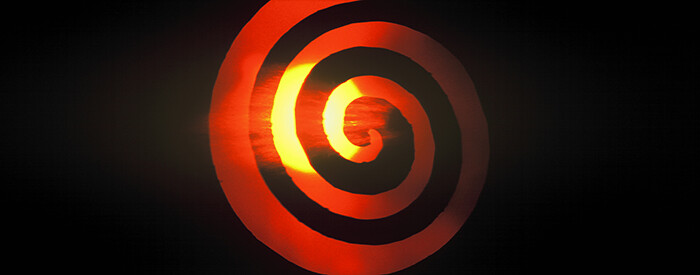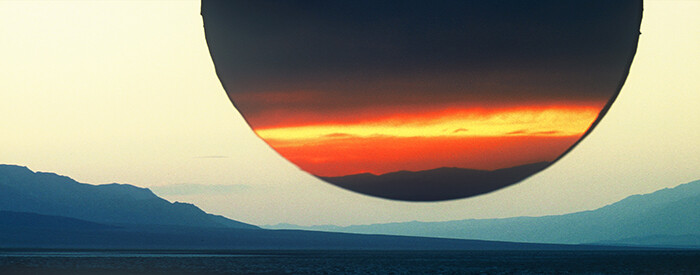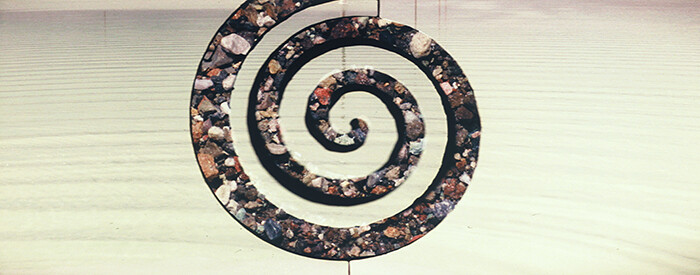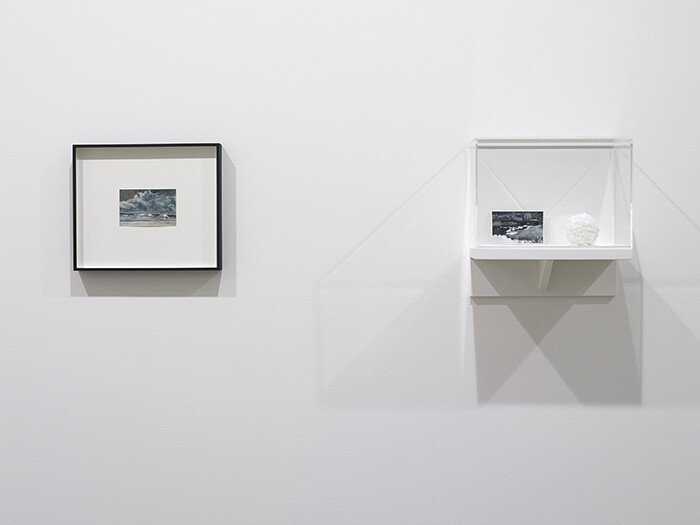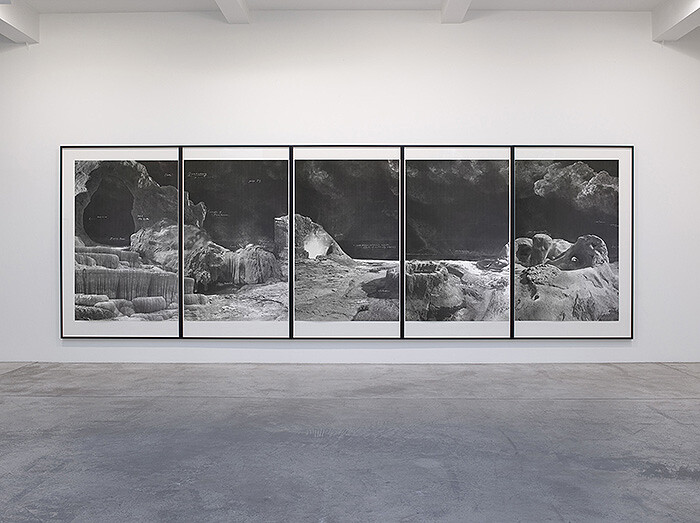In the late 1990s, equipped with directions furnished by the Utah Arts Council, Tacita Dean traveled to the Great Salt Lake in search of Robert Smithson’s Land art masterpiece Spiral Jetty (1970). Though she was ultimately unsuccessful in locating the massive earthwork (likely, it was submerged at the time), her thwarted pilgrimage was far from unfruitful. Having inspired an early sound piece, Trying to Find Spiral Jetty (1997), Smithson’s elusive anti-monument resurfaces—so to speak—sixteen years later in Dean’s latest film, JG (2013). Titled after the late author J.G. Ballard—with whom Dean enjoyed a long-running correspondence based on their mutual interest in Smithson’s work—the 26.5 minute, 35mm film pairs footage of saline landscapes in Utah and California with a voiceover culled from various texts by Smithson and Ballard, including the latter’s 1960 dystopian short story “The Voices of Time.” Offering alternate glimpses into Dean’s salt-infused experience, the current exhibition presents JG in the company of a number of related photographs, paintings, prints, and objects.
Projected widescreen on a continuous loop in the basement of Marian Goodman’s Parisian gallery, JG is a slide show-like succession of landscapes ranging from snowy-white salt flats and crystalline stalagmites to turquoise-blue thermal lakes and fiery sunsets. Making these peculiar terrains appear even more alien, Dean reprises the in-camera technique known as “aperture gate masking” that she developed for FILM (2011), her groundbreaking commission for the Tate Modern’s Turbine Hall. By working with multiple exposures and small stencils placed between the camera lens and the film, she is able to combine topographic features from various vistas within a single frame. A stencil made up of three circles, for example, creates a hybrid landscape in which orbs of rippling, sunset-tinted water hover over a dusky mountain range like ominous, molten asteroids.
It is through stencils that Dean explores the curvaceous form of the Spiral Jetty itself, the presence of which haunts the film in various visual and verbal iterations. Alternately reincarnated as water, sky, salt crystals, and even crawling insects, the iconic coil appears jutting across calm waves, radiant skies, and thickly encrusted salt flats. The intermittent, enigmatic voiceover intensifies the apocalyptic aesthetic of Dean’s filmic collages while provoking uncanny connections between Ballard’s and Smithson’s creative minds. When the narrator (voiced by British character actor Jim Broadbent) seems to address Smithson directly—“I’m sorry, Robert. What can I say? Even the sun is growing cooler.”—he is actually citing “The Voices of Time,” in which Ballard’s main character (who happens to share Smithson’s first name) notably creates a giant, circular mandala in the basin of a dried-out salt lake.
While Dean’s film revels in the various formal and theoretical similarities between Smithson’s earthwork and Ballard’s spiritual symbol, JG’s capricious, unmoored spiral also refers directly to Dean’s own work. As a filmmaker, she has vocally championed her medium of choice, writing and speaking eloquently and urgently about the unique qualities of celluloid. For Dean, therefore, the spiral surely also refers to film itself—whether coiled in a canister, wound around the camera’s take-up spool, or looped through a projector. This association is underscored in The Tail End of Film (2013), one of the JG-related works on view on the gallery’s main floor. In this large-scale, black-and-white photograph, she depicts a salt-encrusted film reel whose unfurled tail and crystalized surface suggest a miniature, hyper-salinized Spiral Jetty. Putting aside the obvious reference to Smithson for a moment, however, the idea of film being preserved in salt, like an Iranian “salt-man” mummy, signals us to behold this curious object like a specimen from a bygone era—material evidence of a pre-digital age.
Similarly artifact-like in terms of their presentation, a series of hand-painted postcards are displayed in wall-mounted vitrines along with small balls, which Dean salinized in the Great Salt Lake. The balls’ crystalline crusts are like natural versions of the layers of gouache that she applies to the postcards in order to mask and metamorphose their imagery. This approach recalls Dean’s in-camera technique, which is somewhat easier to understand, thanks to a series of fourteen offset prints based on JG’s stills. A final, invented landscape, Quatemary (2014), is a massive photogravure based on an assortment of found photographs and Dean’s own cloud drawings. Printed using ten plates, the colorless composite image shows a cavernous and cratered environment annotated with handwritten notes denoting various post-apocalyptic sounding—Ballardian one might say—geological features like “Hell’s Breath” and “Ash Cloud.”
Writing about his own film Spiral Jetty (1970), Smithson likened the editing process to an excavation: “The sun, the spiral, the salt buried in lengths of footage.”1 Smithson, it seems, felt compelled to rescue the physical reality of his artwork from “bits and pieces of Utah, out-takes overexposed and underexposed, masses of impenetrable material.”2 Dean, on the contrary, deliberately entangles evocations of Spiral Jetty within “lengths of footage,” found objects, and fanciful environments. In unfettering Spiral Jetty from a fixed location in time and space, she reveals the artwork’s essence (“Sun, salt, spiral…” as the voiceover repeatedly reminds us) and ascribes it a near-mythical presence.
Robert Smithson, “The Spiral Jetty,” (1972) in Robert Smithson: The Collected Writings, ed. Nancy Holt, (New York: New York University Press, 1979), 114.
Ibid.

